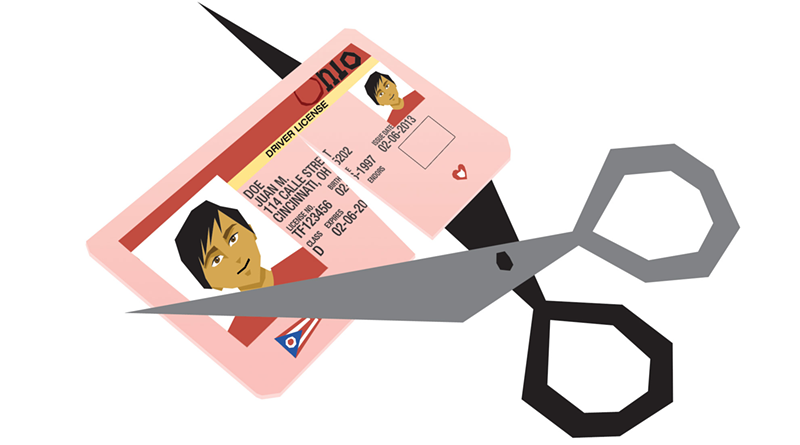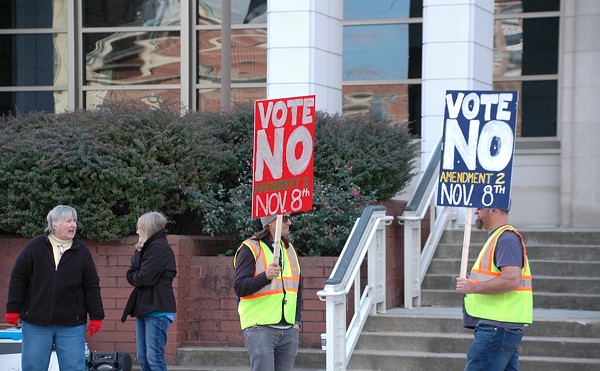E
ver Portillo is legally allowed to live and work in the United States, but the state of Ohio won’t let him obtain a driver’s license.
The discrepancy shows the local side of the illegal immigration issue, even as a broader battle rages in Washington, D.C.
Portillo and Brian Hoffman, Portillo’s attorney, went to the West Broad Street Bureau of Motor Vehicles (BMV) office in Columbus Jan. 29 to get Portillo his driver’s license. After Portillo passed his driving test, he was informed that the BMV is not accepting C33 Employment Authorization Documents (EAD) for driver’s license requirements as of January.
The C33 documents are part of President Barack Obama’s Deferred Action for Childhood Arrivals (DACA) program — the deferred action policy that allows the children of illegal immigrants to legally remain and seek employment and education in the United States. Deferred action doesn’t technically legalize immigrants or provide a path to citizenship, but it adds a layer of security by establishing that the federal government will not pursue charges. Former president Ronald Reagan first used deferred action in 1987 to grant worker permits to some illegal immigrants.
Obama and Democrats argue these children are the true victims of illegal immigration. At no fault of their own, they grew up and went to school in the United States, but still had to live in fear of deportation — at least until DACA came along.
Some state governments do not approve of what they see as an overreach in presidential powers. To these states, DACA — or the DREAM Act, as its more comprehensive version was known in Congress — should have required legislative approval. These states have taken it upon themselves to bar anyone with a C33 card from obtaining a driver’s license. Ohio used to be among 35 states granting licenses, but last month it quietly joined the opposition.
In Ohio, the debate is focused on what counts as legal residence. Supporters of Obama’s policy point to federal and state law, which have historically included deferred action within the requirements of legal residence. Opponents argue the policy doesn’t grant lawful status to illegal immigrants; the policy just defers legal action on the crime.
State law doesn’t define who is eligible for a license. It only prohibits seven categories of people, including “any person who is not a resident or temporary resident of this state.” The state also defines resident in the Ohio Administrative Code as “a native-born or naturalized citizen of the United States or a person who presents credible evidence from the United States Citizen and Immigration Services (USCIS) that the person is a permanent resident of the United States.”
Federal regulation states deferred action recipients fit the definition for legal residence. Federal regulations explicitly say anyone “who has approved deferred action status” is considered to have lawful status.
The story is a little murkier on the USCIS’s end. The frequently asked questions (FAQ) section of the USCIS website states, “An individual who has received deferred action is authorized by the Department of Homeland Security (DHS) to be present in the United States, and is therefore considered by DHS to be lawfully present during the period deferred action is in effect.” But it also adds, “However, deferred action does not confer lawful status upon an individual, nor does it excuse any previous or subsequent periods of unlawful presence.”
In a letter that will soon be sent to the state attorney general’s office, Hoffman says federal regulations and the explanation from USCIS should be enough to establish legal residence under state law — therefore granting eligibility for a driver’s license. But he fears politics are getting in the way of a clean reading of the law: “I can’t actually think of any logical reason why people with this category of EAD cards would be singled out from all the other categories except for some objection to President Obama’s deferred action program.”
On the contradiction between federal regulation and the USCIS website, Hoffman says, “I assume federal regulation trumps an FAQ on a website.”
Judging from the accounts provided by Portillo and Hoffman, there’s little explanation for the BMV’s sudden change in policy. The Ohio Department of Public Safety, which manages the BMV, did not respond to CityBeat’s multiple phone calls and emails by press time.
The impact of the political feud is ultimately felt by C33 recipients like Portillo. When Portillo went to the BMV, he wasn’t expecting any trouble. The 22-year-old from El Salvador had seen some of his friends and peers — including other C33 recipients — get driver’s licenses, so he was expecting to go in and out. He only brought his lawyer as a precaution. Instead, Portillo went through what he described as a frightening experience that renewed fears of deportation: “I just wanted to tell (my attorney), ‘I want to leave right now and leave everything in here.’ ”
Strangely enough, Portillo got his temporary license a couple weeks before his latest BMV visit — a testament to how recently the rules for driver’s licenses were changed. But in his next visit, Portillo was informed he shouldn’t have been allowed to get his temporary license in the first place.
Portillo, who recently started working as a waiter at a Mexican restaurant in Columbus called El Vaquero, was hoping to get his driver’s license after years of living in the shadows. For him, getting a license is the first step in the pursuit of bigger dreams. He knows it’s going to be difficult, but he already has plans for attending Columbus State Community College and hopefully Ohio State University after that.
But the recent events have made Portillo unsure about his future. After years of hiding in fear, the Obama policy came with the promise of relief. With the state’s recent actions, that relief is fading away. ©






